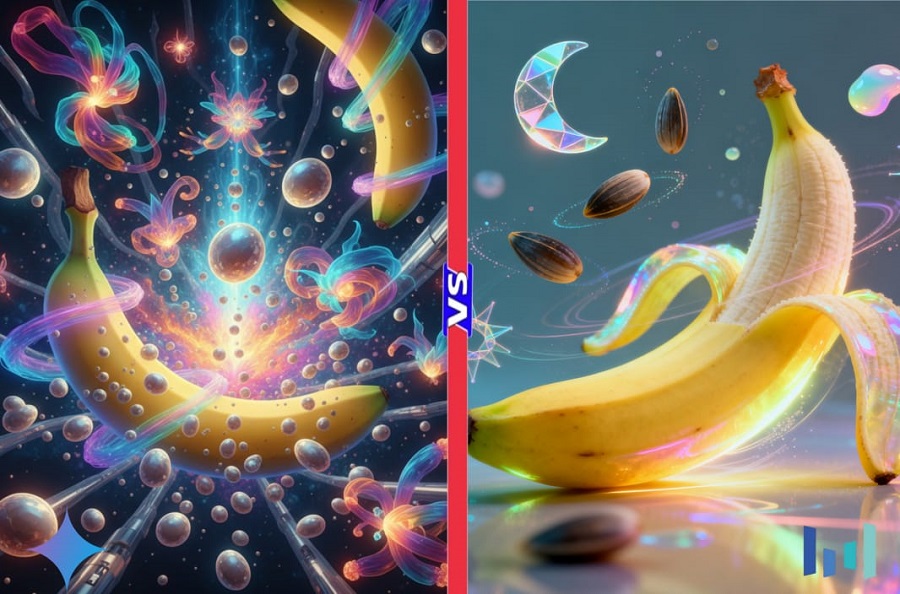Artificial intelligence has become the heartbeat of digital creativity. Two names dominate current discussions: Google Nano Banana vs Bytedance Seedream 4.0. Both bring unique innovations, but they differ in design philosophy, cultural intent, and technological underpinnings. This article explores their evolution, strengths, weaknesses, and the broader implications for AI’s future.
Introduction
AI-powered tools are no longer futuristic experiments. They shape industries, influence marketing strategies, and empower creators. Google Nano Banana and Bytedance Seedream 4.0 are positioned at the intersection of creativity and computation. While Google’s approach emphasizes precision, scale, and productivity, Bytedance leans into entertainment, expression, and social influence. Together, they represent two sides of the same coin in the AI revolution.
Background and Origins
The evolution of Google’s Nano Banana project
Google’s Nano Banana project grew out of its Imagen and Gemini research pipelines. Initially, it was a quirky internal experiment designed to showcase lightweight generative models that could work on smaller devices. Over time, it matured into a consumer-facing product blending efficiency with Google’s signature depth of knowledge. The name “Nano Banana” reflects Google’s tradition of playful branding, much like Android versions once named after desserts.
Bytedance’s Seedream journey to version 4.0
Bytedance’s Seedream began as an AI-powered creative suite for short videos. Its earliest versions supported auto-captioning, scene transitions, and simple stylization. With user feedback from TikTok and CapCut creators, Bytedance pushed development aggressively, eventually releasing Seedream 4.0. This iteration expanded into advanced text-to-image synthesis, multimodal storytelling, and real-time generative effects, positioning it as a challenger to Western AI models.
Naming strategies: playful vs aspirational branding
Nano Banana and Seedream differ starkly in naming philosophy. Nano Banana’s quirky identity makes AI seem approachable, even humorous. Seedream, by contrast, positions itself as visionary and aspirational, with “Seedream” evoking imagination and the future. Branding is not trivial; it influences how users perceive trust, professionalism, and emotional connection with technology.
The global rivalry between Google and Bytedance
The competition mirrors broader geopolitical and corporate rivalries. Google, an American giant, represents infrastructure, search dominance, and global productivity. Bytedance, a Chinese powerhouse, represents cultural influence, social platforms, and viral creativity. Their AI products serve not only as tools but also as symbols of East-West competition in the digital age.
Core Technology and Architecture
Underlying AI models and neural networks
Nano Banana leverages diffusion models optimized for efficiency. Its neural architecture allows fast rendering of high-quality images while conserving computational resources. Seedream 4.0 combines diffusion networks with transformer-based alignment, excelling in real-time tasks where speed and style matter. This hybrid architecture helps it adapt quickly to social content demands.
Training datasets and scale differences
Google taps into curated multilingual datasets linked to its search, YouTube, and Google Images repositories. This provides broad, balanced outputs. Bytedance trains Seedream heavily on user-generated video and image content from TikTok, which makes it uniquely attuned to trends, memes, and cultural nuances. The difference shows in outputs: Nano Banana tends to be encyclopedic, Seedream more expressive and viral-ready.
Cloud-based integration and accessibility
Nano Banana integrates with Google Cloud and productivity tools like Docs, Slides, and Drive. This makes it invaluable for professional and academic use. Seedream thrives inside TikTok and CapCut, offering creators direct integration with video editing pipelines. Accessibility defines use cases: Google focuses on work and knowledge, Bytedance on fun and sharing.
APIs, algorithms, and user feedback loops
Google provides APIs for developers and enterprise integration. Its algorithmic updates are slow but precise, ensuring enterprise reliability. Bytedance iterates Seedream rapidly through feedback from millions of TikTok creators, making it adaptive to cultural trends. These feedback loops reveal a difference in philosophy: stability versus adaptability.
Feature Comparison: Google Nano Banana vs Seedream 4.0
Generative image quality and style diversity
Google Nano Banana has been praised for producing crisp, photorealistic images. Its diffusion process handles lighting, perspective, and texture with remarkable accuracy. For professionals needing realistic mockups or editorial visuals, Nano Banana often delivers results close to stock photography. By contrast, Seedream 4.0 shines in style diversity. Whether it’s anime-inspired art, surreal dreamscapes, or cinematic visuals, Seedream pushes creative boundaries. This makes it the preferred choice for influencers, designers, and experimental creators. I gave this prompt to both AI models “Genrate a futuristic digital artwork showing glowing bananas mixed with floating seeds that transform into colorful imaginative shapes, blending technology with creativity. Use vibrant colors, sleek details, and a dreamlike atmosphere“. And this was the result of it:

Speed, efficiency, and latency benchmarks
One of Nano Banana’s strongest advantages is efficiency. Running on Google’s optimized Tensor Processing Units (TPUs), it generates images significantly faster than many competitors. Seedream 4.0 is quick too, but heavy loads from TikTok integrations sometimes create latency during peak hours. For enterprises and productivity-focused users, speed consistency gives Nano Banana an edge. For casual creators, Seedream’s slightly slower response time is usually offset by its artistic flexibility.
Text-to-image vs text-to-video capabilities
Seedream 4.0 has made waves with its early-stage text-to-video synthesis. Users can type a short prompt and receive a short animated clip that feels almost TikTok-ready. Nano Banana, however, focuses primarily on text-to-image and image editing. While Google is rumored to be working on advanced video tools, Seedream currently leads this space. If video creativity is a priority, Seedream offers a unique advantage.
Multilingual support and cultural adaptability
Seedream 4.0 leverages Bytedance’s experience with global short-form content to provide deep multilingual and culturally adaptive outputs. Prompts written in Chinese, Japanese, Arabic, or Hindi still yield nuanced results. Nano Banana is excellent in English and performs well in other major languages, but its cultural adaptability is sometimes narrower. For example, Seedream often incorporates regional artistic traditions more fluidly, while Nano Banana focuses on universal clarity.
Integration with ecosystems and platforms
Google’s ecosystem focus is unmistakable. Nano Banana works directly within Google Workspace, Android devices, and Chrome extensions. Businesses already invested in Google’s tools see Nano Banana as a natural fit. By contrast, Seedream connects tightly to Bytedance products. TikTok creators can generate and publish directly without external editing. This integration makes Seedream attractive to social media influencers, while Nano Banana appeals more to enterprises, educators, and research teams.
Common Attributes
- Both are cloud-based
- Both use diffusion models
- Both emphasize user creativity
- Both benefit from massive data ecosystems
Rare Attributes
- Nano Banana’s integration into productivity tools
- Seedream’s real-time video-first generative abilities
- Nano Banana’s emphasis on humor in branding
- Seedream’s cultural adaptation through TikTok data
Unique Attributes
- Nano Banana’s lightweight “nano” efficiency on smaller devices
- Seedream’s 4.0 iteration focused on multimodal content blending
How to Use These Tools
Step 1: Access the platforms
Sign into Google’s productivity suite for Nano Banana or TikTok/CapCut for Seedream. Availability depends on region and subscription models.
Step 2: Choose your creative goal
Use Nano Banana for presentations, educational graphics, or design prototypes. Use Seedream for TikTok shorts, music videos, or viral content.
Step 3: Generate and refine
Provide prompts, refine outputs, and integrate them into projects. Google emphasizes structured prompts, while Seedream thrives with looser, trend-based inputs.
Step 4: Publish and share
Export content into professional workflows with Nano Banana or publish directly on TikTok using Seedream.
Questions and Answers
Which is better for professional use?
Nano Banana is stronger for business, academic, and structured creativity due to its integration with Google Docs, Slides, and Drive.
Which is better for entertainment?
Seedream 4.0 dominates entertainment and social content, thanks to its TikTok integration and real-time generative abilities.
Do both use diffusion models?
Yes, though Google focuses on precision-based diffusion while Bytedance blends diffusion with transformer alignment for speed.
Are they available globally?
Nano Banana has wider enterprise availability. Seedream is regionally restricted but spreading rapidly with TikTok adoption.
Which produces higher-quality images?
Nano Banana excels in photorealism. Seedream produces more stylistic and trend-based outputs.
What’s the biggest difference?
The biggest difference is intent: Nano Banana focuses on productivity, Seedream focuses on culture.
Conclusion
Google Nano Banana and Bytedance Seedream 4.0 are two faces of generative AI. Nano Banana prioritizes efficiency, professionalism, and humor-driven branding. Seedream emphasizes artistry, cultural resonance, and entertainment. Both matter in shaping the AI future—one from the boardroom, the other from the stage. Whether you are a professional building a presentation or a creator chasing viral trends, understanding their differences helps you choose the right tool for the right context.



